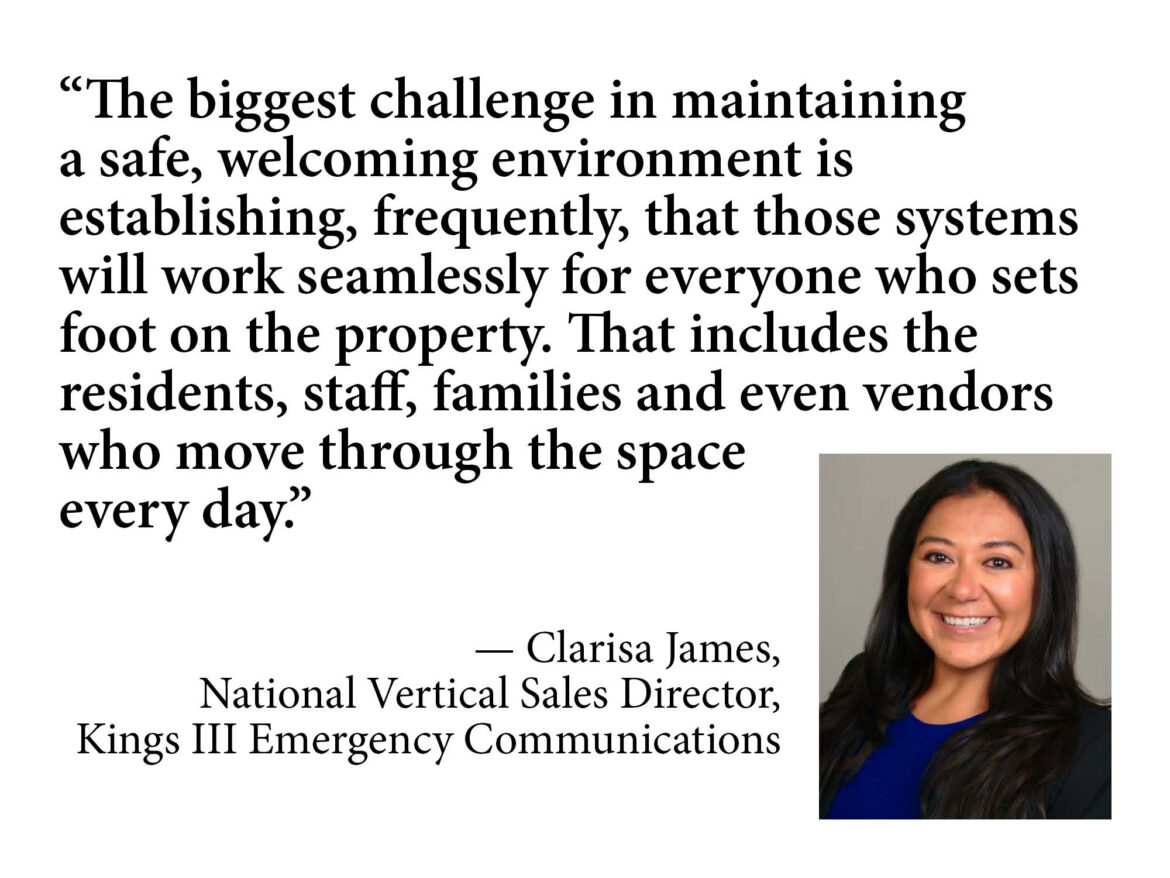Establishing trust is an ongoing challenge for many seniors housing communities, with operators continually working to draw in new residents while simultaneously recruiting staff in an industry plagued by high turnover and labor gaps. In both efforts, evidence of the owner’s commitment to safety infrastructure can be a deciding factor that brings people in for the long term, according to Clarisa James, national vertical sales director at Kings III Emergency Communications.
“Families want reassurance that loved ones are safe, not only in their living areas but throughout the community,” James says. “When communities invest in maintaining and modernizing safety infrastructure, it communicates a strong message of quality care and operational stability. That builds confidence that preserves family engagement and keeps residents comfortable over long-term stays. This approach strengthens relationships and reinforces community.”
Kings III helps seniors housing clients showcase safety by equipping their properties with emergency telephones, especially in code-required areas (such as elevators) and in high-traffic or isolated spaces. In James’ experience, communities that invest in these and other safety improvements, from better lighting and signage to reliable emergency communication systems, foster trust in the facilities and their aptitude to respond appropriately in emergencies large and small.
“Communities are broadening their definition of safety to include more than clinical response,” James says. “It’s about clear communication, accessible help and confidence that if something happens, anyone can reach assistance quickly. Operators are looking for layered solutions that help to protect everyone, not just those in their direct care.”
Building Trust Through Code-Driven Change
Most states have adopted codes mandating that elevator emergency communications now include video and two-way messaging capabilities for hearing- or speech-impaired passengers. Once a state has adopted the updated code, those requirements apply to any new construction or modernization project, meaning they take effect whenever elevators are newly installed or substantially upgraded.
In-elevator video capabilities (activated only when the elevator call button is pushed) can enable operators to visually differentiate accidental activations from genuine distress calls. Messaging screens help operators communicate with nonverbal passengers using text yes/no questions, which the passenger can answer using pushbuttons.
This capability is particularly impactful for senior care building managers, whose resident populations are more likely to include individuals with hearing impairments, cognitive decline or other medical conditions that limit communication. In situations such as these, in-cab video and two-way messaging help operators assess the caller’s condition, maintain the connection and keep the caller calm while sending assistance.
Modernization That Inspires Confidence
The latest code advancements point to a larger goal: to help ensure that anyone in need can reach help quickly and reliably. That same focus on reliability should also guide how communities modernize the technology supporting their emergency systems.
As communities modernize to keep up with evolving technology, special attention should be given to the systems that support life safety and emergency communication. More broadly, the shift toward connected, digital infrastructure is prompting many owners to re-evaluate how their emergency phones communicate and how to ensure those connections remain reliable as older technologies phase out.
Many communities are moving away from traditional analog landlines as providers scale back support and costs continue to rise. In most areas of business, that shift has led to internet-based phone service, but applying Voice over Internet Protocol (VoIP) to emergency systems can create major vulnerabilities. Because these lines must stay live around the clock, even brief power or network disruptions can pose safety risks. Cellular technology has become the preferred alternative, providing a secure, independent connection that maintains compliance and reliability when it matters most.
These updates extend beyond properties adopting new video and two-way messaging requirements, though they become especially critical for properties adopting new video and two-way messaging systems that rely on a stable data connection.
Trust Built on Reliable Performance
Modernization only has an impact if those systems continue to perform as intended. The presence of residents with hearing, speech and cognition challenges underscores the need for intuitive operation in all safety systems, James says. In choosing safety equipment, seniors housing operators should lean toward options that require little or no training for passengers. This increases the likelihood that anyone who accesses the community will be able to use safety resources successfully in an emergency.
Operators should test emergency communication systems often, James says. Kings III encourages clients to test emergency phones regularly. The company also offers an optional auto testing feature that regularly checks customers’ emergency phone systems for dial tone and power, helping to ensure they are always ready for use.
“The biggest challenge in maintaining a safe, welcoming environment is establishing, frequently, that those systems will work seamlessly for everyone who sets foot on the property,” she says. “That includes the residents, staff, families and even vendors who move through the space every day.”
Beyond Technology: The Human Touch
Reliable systems are only part of the equation; equally important are the people behind them. Kings III’s emergency operators are highly trained and certified, able to provide pre-arrival medical instruction to callers awaiting emergency services. If additional help is necessary, operators stay on the line while alerting onsite personnel or local emergency dispatchers. They can also patch in family members to help comfort a resident while assistance is on the way.
That same level of care extends beyond traditional emergencies. Residents, staff and visitors need to feel confident that help is available in any moment of uncertainty, not only when a crisis occurs. Kings III operators often respond to situations that may seem routine but can still be distressing for those involved, such as a resident who becomes disoriented and presses the elevator call button for reassurance, someone who accidentally locks themselves out of their room or a visitor who feels lost after hours and cannot find their way back to the main entrance.
Even when these calls do not require emergency dispatch, they play a key role in preserving a sense of security. Having a calm, capable voice on the other end of the line reassures residents and restores order in moments that might otherwise cause confusion or fear. This attention to both practical and emotional safety strengthens trust in the community’s overall responsiveness and care.
Every Safety Investment Strengthens Trust
In senior living, trust is built through communication and action, as well as through visible and reliable safety systems. By embracing technology that meets modern codes, maintaining rigorous testing and prioritizing the human connection behind every call, communities demonstrate their unwavering commitment to residents’ well-being. Families notice when a community takes preparedness seriously, and staff feel more confident in their workplace. Most importantly, residents gain peace of mind knowing help is never out of reach.
This sponsored content was written in conjunction with Kings III Emergency Communications, a content partner of Seniors Housing Business.
Learn more about Kings III Emergency communications here.

